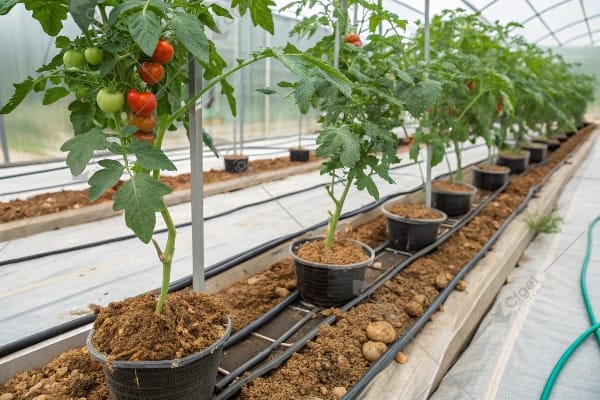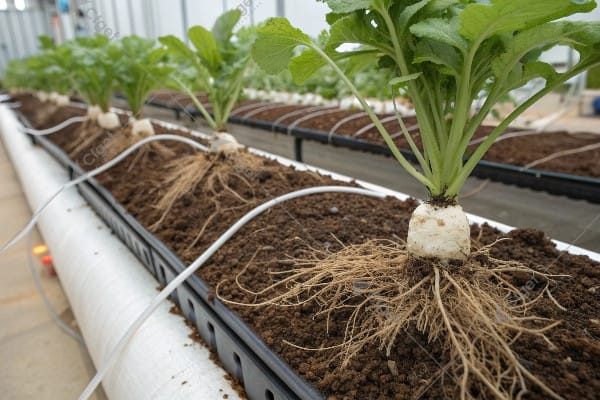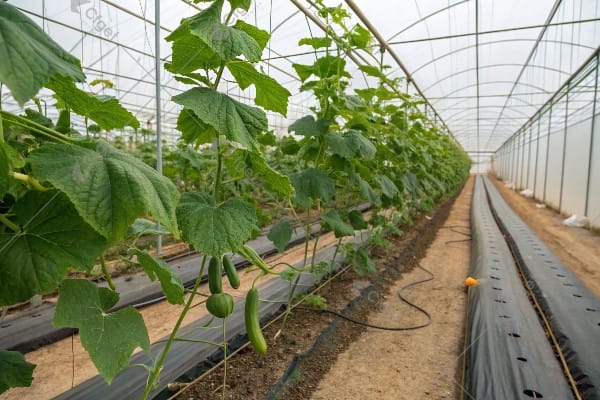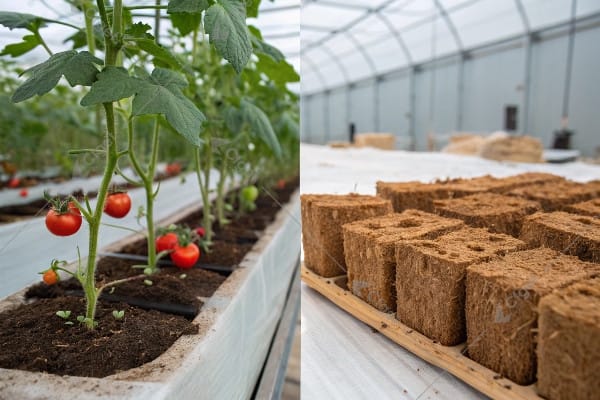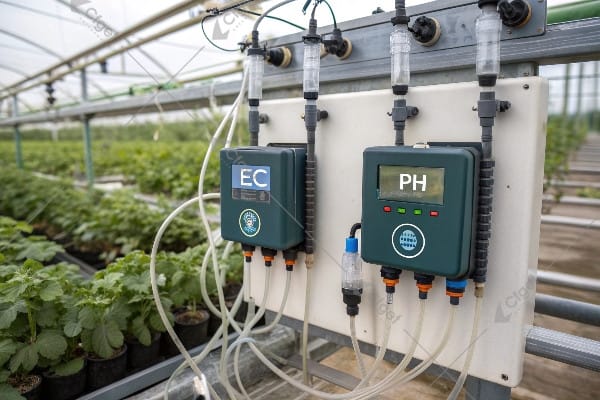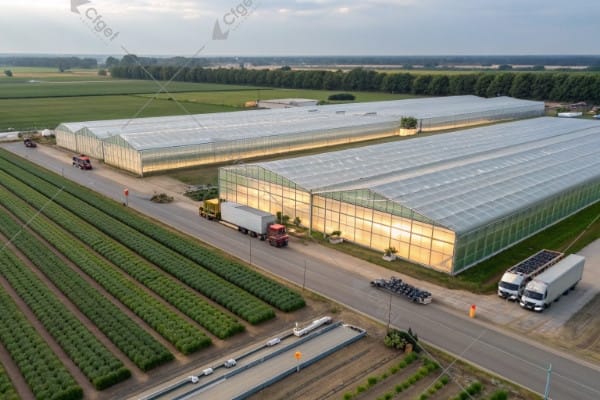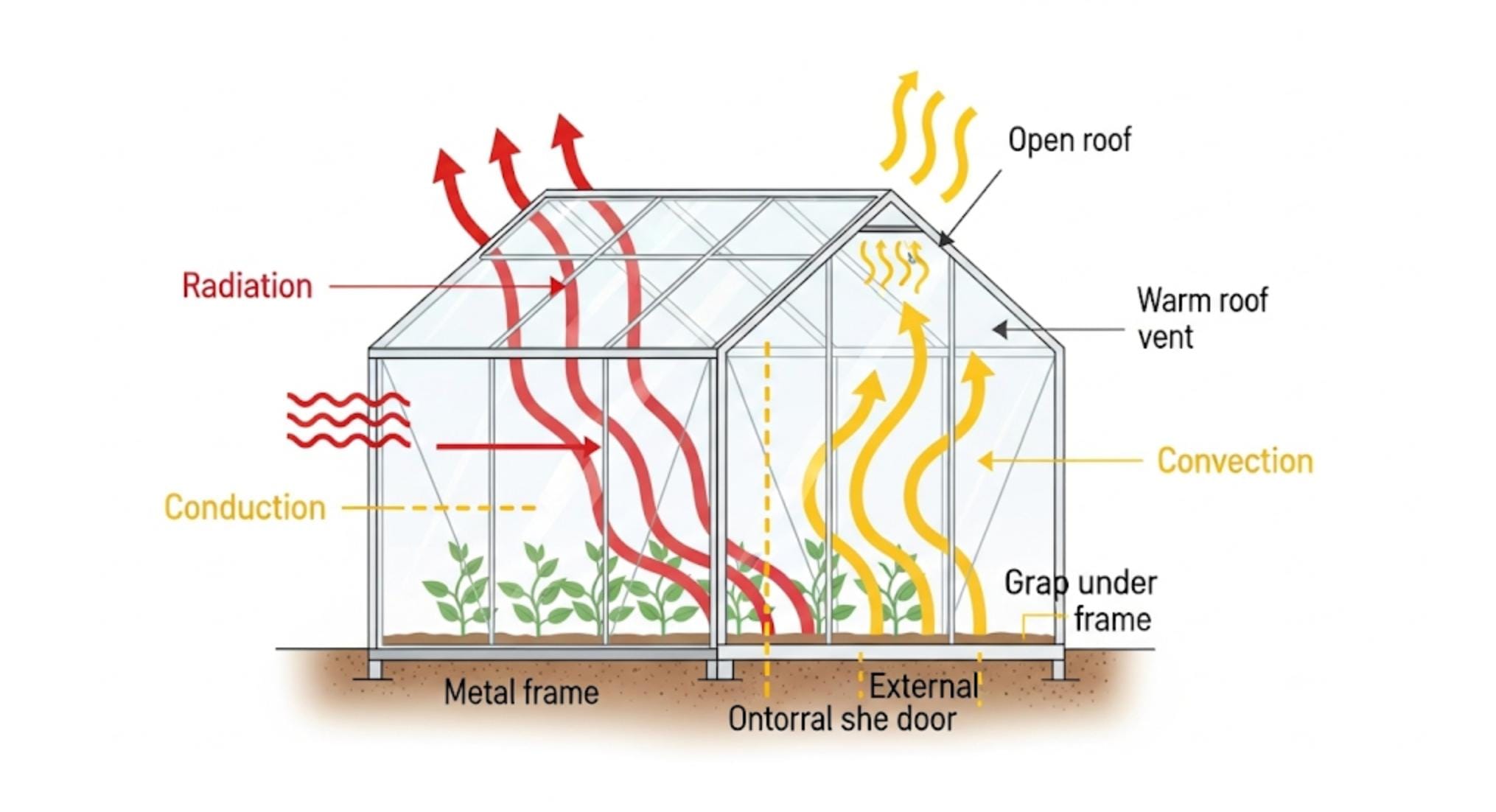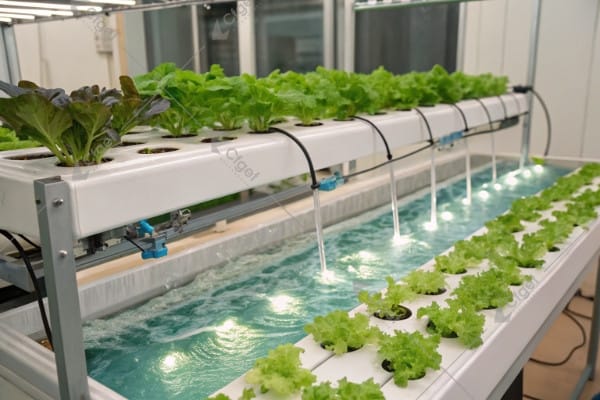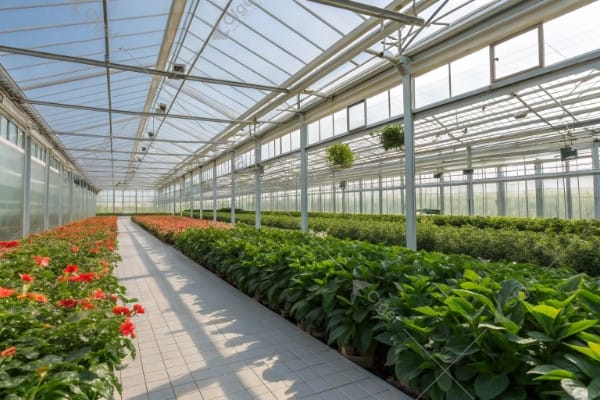Inconsistent watering and nutrient delivery destroy tomato and cucumber yields when you need them most. Traditional soil systems create waterlogged roots, uneven nutrient distribution, and disease problems that devastate harvests. I’ve helped countless growers overcome these challenges by implementing precision drip irrigation systems that deliver exactly what plants need, when they need it.
Drip irrigation combined with soilless substrates like coco coir or rockwool delivers precise water and nutrient control, resulting in 40-60% higher yields of premium tomatoes and cucumbers while eliminating root diseases and reducing water usage by up to 50%.
Precision drip irrigation creates optimal growing conditions in substrates.
The transition from traditional growing methods to substrate-based drip systems represents a fundamental shift in how we approach plant nutrition and water management for maximum productivity.
The Perfect Match: Why Drip Systems & Substrates Maximize Root Health?
Poor root health kills more crops than most growers realize. Overwatering, underwatering, and inconsistent moisture levels create stressed root systems that cannot support heavy fruit production. I’ve seen entire greenhouse operations fail because root problems prevented plants from reaching their genetic potential during critical fruiting periods.
Drip irrigation systems paired with soilless substrates create optimal root zone conditions by delivering precise water and oxygen ratios, maintaining consistent moisture levels, and eliminating soil-borne pathogens that commonly destroy tomato and cucumber root systems.
Healthy root development thrives in properly managed substrate systems.
The synergy between drip irrigation and soilless substrates creates growing conditions that are impossible to achieve with traditional soil methods. Substrates like coco coir and rockwool provide the perfect balance of water retention and drainage, holding adequate moisture for plant needs while allowing excess water to drain away. This prevents the waterlogged conditions that lead to root rot and other devastating diseases.
Drip irrigation systems deliver water and nutrients directly to the root zone with surgical precision. Unlike flood irrigation or overhead watering, drip systems minimize water contact with plant foliage, reducing disease pressure while ensuring every drop reaches where it’s needed most. The controlled delivery also prevents the feast-or-famine cycles that stress plants and reduce productivity.
The substrate material itself plays a crucial role in root health optimization. Both coco coir and rockwool create environments with excellent air-to-water ratios in the root zone. This means roots have constant access to both moisture and oxygen, the two elements most critical for healthy development. The sterile nature of these substrates also eliminates the soil-borne pathogens that commonly attack tomato and cucumber roots.
Root zone management becomes much more precise with substrate systems. We can monitor and adjust moisture levels, nutrient concentrations, and pH with accuracy that’s impossible in soil. This precision allows us to maintain optimal conditions throughout the entire growing cycle, supporting continuous root development and maximum nutrient uptake capacity.
| Root Health Factor | Substrate + Drip | Traditional Soil | Performance Advantage |
|---|---|---|---|
| Oxygen availability | Optimal 15-20% | Variable 5-15% | Consistent root respiration |
| Moisture consistency | ±5% variation | ±20% variation | Reduced plant stress |
| Disease pressure | 90% reduction | Baseline risk | Healthier root systems |
| Nutrient uptake | Direct delivery | Search required | 30% more efficient |
A Temperate Grower’s Guide to Achieving Consistent, High-Quality Harvests?
Seasonal variations and unpredictable weather destroy harvest consistency in temperate climates. Traditional outdoor growing leaves crops vulnerable to temperature swings, irregular rainfall, and pest pressure that creates unmarketable produce. I’ve worked with growers who lost entire seasons to weather-related crop failures that could have been prevented with controlled environment systems.
Substrate-based drip irrigation systems in protected environments deliver consistent, high-quality tomatoes and cucumbers year-round in temperate climates, maintaining optimal growing conditions regardless of external weather while extending productive seasons by 4-6 months annually.
Controlled environment systems ensure consistent harvests in temperate climates.
Temperate climate growing presents unique challenges that substrate drip systems address effectively. Temperature fluctuations that commonly occur in spring and fall can stress plants and reduce fruit quality. Protected growing environments combined with precise irrigation control create stable conditions that support continuous production when outdoor growing becomes impossible.
The extended growing season possible with substrate systems transforms the economics of temperate vegetable production. While outdoor growers are limited to 4-5 months of productive growing, controlled environment substrate systems can produce for 10-11 months annually. This extended season captures premium pricing during off-season periods when fresh, local produce commands the highest prices.
Quality consistency becomes achievable when environmental factors are controlled. Substrate systems prevent the soil compaction and nutrient depletion that occurs with traditional field growing. The precise nutrient delivery ensures plants receive optimal nutrition throughout their productive life, resulting in uniform fruit size, consistent ripening, and superior flavor development.
Water management in temperate climates requires understanding seasonal variations in plant water needs and environmental conditions. Spring growing requires different irrigation strategies than summer production. Our drip systems adjust delivery schedules and volumes based on plant growth stages, environmental conditions, and seasonal requirements.
| Seasonal Factor | Substrate Control | Traditional Growing | Quality Impact |
|---|---|---|---|
| Temperature stability | ±2°C variation | ±10°C swings | Consistent fruit development |
| Growing season | 10-11 months | 4-5 months | 2x annual production |
| Water efficiency | 50% reduction | Baseline usage | Lower production costs |
| Harvest timing | Precise control | Weather dependent | Market optimization |
Coco Coir vs. Rockwool: Choosing the Right Substrate for Your Drip System?
Wrong substrate choice destroys system performance and wastes months of growing time. Many growers select substrates based on price alone, not understanding how different materials affect plant performance and system management requirements. I’ve helped growers recover from substrate failures that cost them entire growing seasons and thousands in lost revenue.
Coco coir offers superior water retention and organic benefits for longer-season crops, while rockwool provides precise control and faster establishment for intensive production systems, with the choice depending on crop type, growing experience, and production goals.
Different substrates offer distinct advantages for specific growing situations.
The substrate selection decision impacts every aspect of your growing operation, from daily management requirements to long-term crop performance. Coco coir, derived from coconut husks, provides excellent water retention characteristics while maintaining good drainage. This makes it more forgiving for newer growers who are still learning precise irrigation timing. The organic nature of coco coir also supports beneficial microbial activity that can enhance plant health and nutrient uptake.
Rockwool, manufactured from spun volcanic rock, offers superior precision and control for experienced growers. Its uniform structure provides consistent water and air ratios throughout the root zone, making it ideal for intensive production systems where maximum yields are the priority. Rockwool’s sterile nature eliminates variables that can affect plant performance, but requires more precise management to achieve optimal results.
The water management characteristics of each substrate require different irrigation strategies. Coco coir holds more water per unit volume, requiring less frequent irrigation cycles but larger volumes per application. Rockwool drains more freely, requiring more frequent but smaller irrigation events. Understanding these differences is crucial for developing effective fertigation schedules.
Cost considerations extend beyond initial substrate purchase prices. Coco coir can often be reused for multiple growing cycles with proper treatment, reducing long-term costs. Rockwool typically requires replacement after each crop but offers more predictable performance characteristics. The choice often depends on labor availability for substrate preparation and disposal.
| Substrate Characteristic | Coco Coir | Rockwool | Best Application |
|---|---|---|---|
| Water retention | High (8-10x weight) | Moderate (6-8x) | Long-season crops |
| Drainage rate | Moderate | Fast | Intensive production |
| pH stability | Requires buffering | Stable | Experienced growers |
| Reusability | 2-3 cycles | Single use | Cost-sensitive operations |
| Forgiveness factor | High | Low | Beginning growers |
Mastering Fertigation: 4 Keys to Nutrient Scheduling for Tomatoes & Cucumbers?
Poor nutrient timing destroys fruit quality and reduces yields when plants need nutrition most. Random fertilizer applications create nutrient imbalances that stress plants and produce unmarketable fruit. I’ve diagnosed countless nutrient problems that resulted from improper fertigation scheduling, costing growers premium market opportunities and reducing profitability.
Successful fertigation requires mastering four critical elements: growth stage nutrition matching, daily timing optimization, concentration management based on environmental conditions, and continuous monitoring with adjustments to maintain optimal plant nutrition throughout the productive cycle.
Precision fertigation systems deliver optimal nutrition throughout growing cycles.
The first key to successful fertigation lies in understanding how plant nutritional needs change throughout different growth stages. Young tomato and cucumber plants require higher nitrogen ratios to support vegetative development, while fruiting plants need increased potassium and calcium to support fruit development and prevent disorders like blossom end rot. We adjust nutrient formulations weekly based on plant development stages and environmental conditions.
Daily timing optimization represents the second critical element of effective fertigation. Plants uptake nutrients most efficiently during periods of active growth, typically during morning hours when photosynthesis rates are highest. We schedule multiple small fertigation events throughout the day rather than single large applications, ensuring consistent nutrient availability while preventing salt buildup in the root zone.
The third key involves managing nutrient concentrations based on environmental conditions and plant stress levels. Hot, sunny conditions increase water uptake rates, requiring lower nutrient concentrations to prevent salt stress. Cool, cloudy conditions reduce water uptake, requiring higher concentrations to maintain adequate nutrition. This dynamic adjustment prevents both nutrient deficiencies and toxicities.
Continuous monitoring and adjustment form the fourth pillar of successful fertigation management. We monitor electrical conductivity (EC) and pH levels multiple times daily, adjusting nutrient solutions to maintain optimal ranges. Drainage monitoring tells us whether plants are receiving appropriate irrigation volumes, while tissue testing confirms that nutrient uptake is occurring as planned.
| Fertigation Key | Management Focus | Monitoring Method | Adjustment Frequency |
|---|---|---|---|
| Growth stage nutrition | N-P-K ratios | Weekly tissue tests | Weekly formulation |
| Daily timing | Multiple small doses | Plant uptake rates | Daily scheduling |
| Concentration management | EC/pH control | Continuous sensors | Real-time adjustment |
| Monitoring/adjustment | System performance | Drainage analysis | Multiple daily |
The integration of these four elements creates a fertigation system that responds dynamically to plant needs while maintaining optimal growing conditions. Proper implementation results in plants that receive exactly the right nutrition at the right time, supporting maximum fruit production and premium quality that commands the highest market prices.
Conclusion
Drip irrigation in substrates transforms tomato and cucumber production through precise root zone management, extended growing seasons, and optimal nutrition delivery that maximizes both yield and quality.

